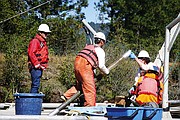Getting to the core of the issue
During the past three weeks workers aboard boats extracted hundreds of sediment core samples from the bed of the lower Coeur d’Alene River, and the work continues this coming week as the federal government collects data for mapping heavy metals pollution hotspots.
Ed Moreen, remedial project manager for the U.S. Environmental Protection Agency, said the agency wants to better understand where the sediments with harmful levels of metals are most likely to be picked up by flows and transported to Lake Coeur d’Alene.
Knowing this will help the EPA prioritize its actions to protect the public in its role of cleaning up historic mining pollution in the Coeur d’Alene Basin, and keeping metals out of Lake Coeur d’Alene.
“We have an understanding of what the riverbed looks like, but we don’t have an in-depth understanding,” Moreen said. “We don’t know where the really, extremely high-concentration areas are — what I call hotspots.”
What the EPA does know right now: 390 tons of lead mining waste washes into Lake Coeur d’Alene from the river each year. At the same time, the North Fork and South Fork are only feeding the main stem about 32 tons of lead.
“We’re having an incredible increase in lead pickup in this segment of river, between Harrison and Enaville,” Moreen said Friday, as he cruised through a connecting channel between Killarney Lake and the main stem of the river. He took reporters to see the core sample collection process while it is underway.
The core sampling work is concentrated between Cataldo and Harrison, a stretch of 30 river miles. The upstream section of the main stem, between Cataldo and Enaville, is more difficult to access and the stream bed there is too rocky for core sampling.
Dixon Marine Services Inc., based in Inverness, Calif., is a subcontractor doing the actual sampling. The company uses equipment that pushes a roughly 7-foot metal tube into the river bottom using vibration. Inside the metal tube is clear plastic tube that holds the sediment core sample.
Samples already are being analyzed, Moreen said. The cores are cut down the middle, and lead readings are taken using hand-held X-ray fluorescence instruments. Other samples are sent to a lab for confirmation of results.
“We want to understand where that contact point is between pre-mining impacted sediments and the mining heyday period when you actually have direct discharge into the system,” Moreen said. “It’s too early for us to say what the patterns are from this particular coring exercise because we’re right in the middle of collecting the samples and analyzing the samples.”
Still they have found massive increases in lead concentrations from pre-mining sediment accumulations, at around 56 to 62 parts per million, to sediments that accumulated after mining activities started upstream, which show concentrations of 2,500 to 3,500 parts per million of lead. Lead is harmful to people and wildlife at any exposure level.
There is a lot of cleanup going on upstream in the Silver Valley, and preparation for continued cleanup, which will cut down on lead flowing into the tributaries of the main stem of the Coeur d’Alene River. The EPA also is trying to cut down on zinc going into the river, but that battle is being fought mostly at the source, Moreen said.
The core sample collection process wraps up at the end of this coming week, though the evaluation of the samples will continue. Then the data will be mapped to look for patterns of sediment migration.
“It’s never done,” Moreen said. “It’s more of an evolution in your knowledge and your understanding of the system.”
Gathering the sediment samples will cost $250,000, he said. The work is paid for with settlement dollars from mining companies.



